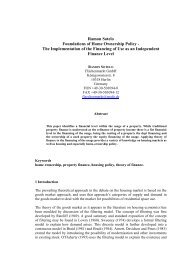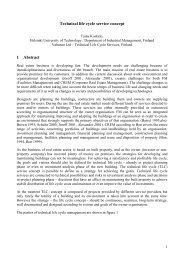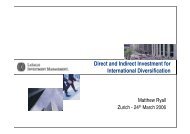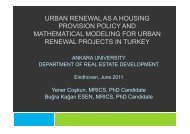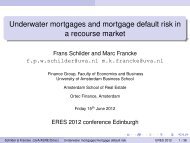Adding Value Through CREAM Alignment
Adding Value Through CREAM Alignment
Adding Value Through CREAM Alignment
Create successful ePaper yourself
Turn your PDF publications into a flip-book with our unique Google optimized e-Paper software.
Paradigm<strong>Adding</strong> <strong>Value</strong> <strong>Through</strong> <strong>CREAM</strong> <strong>Alignment</strong> 2012The CRE manager needs to establish how an organisation actually works andunderstand the beliefs and values espoused by the client organisation so that the realestate and workplace solutions can support and enhance the culture of the organisationor "organisational DNA". It is also important to establish micro cultures, the way thatpeople actually work in the office environment; this could be considered to be the"workplace DNA".The brand of an organisation is more than the marketing materials and the companylogo; it has to reflect the whole ethos of the organisation. It is the ethos, or brand identity,that helps an organisation differentiate itself in the market place (Haynes andNunnington 2010).An organisation can use its real estate and facilities to communicate clearly toemployees and customers its brand identity. The location of an organisation's buildings,their external and internal design and appearance all send signals about the companyculture and brand (Haynes and Nunnington 2010).A successful brand will be fully integrated into the business: it will reflect the culture of theworkplace, the values of the organisation, the perceptions of customers and clients, even thenature of the business’s assets (McNestrie 2009).Branding is strongly associated with the consumer and retail sector. However, it canperform just as important a role in office working environments. The branding of officeenvironments can clearly reflect the culture of an organisation, or corporate DNA. If thereal estate and facilities professionals are not consciously managing the brand of acompany, then by default they may be sending negative signals to their customers andemployees (Haynes and Nunnington 2010).ProcessesTo ensure that the building provision and specifications matches the organisationaldemand for space requires the CRE manager to have a clear understanding of the workprocesses undertaken in the organisation.Research undertaken by Greene and Myerson (2011) aimed to establish differentclassifications of knowledge workers based on their mobility patterns. This research wasnovel in a sense that along with interviews and ethnographic studies the research used adrawing exercise in the interview process as a way of graphically capturing theinterviewees’ perception of their office mobility. This research identified four charactertypes for knowledge workers. The anchor and the connector were mainly confined to theoffice environment whilst the gatherer and navigator were more mobile and had thefreedom to roam away from the office environment (Greene and Myerson 2011). Clearlyestablishing the needs of office-based occupiers and mobile workers is an essentialelement in identifying the office space requirements.The matching of processes to place is a fundamental one and is developed even furtherby research undertaken by Duffy et al (2011) who argues that context and purposeshould also be taken into account. This research argues that the creative processes of7 | P a g e



